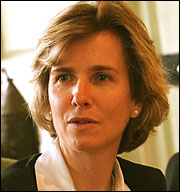
Leith Sharp.
When Leith Sharp left her native Australia for a five-month tour of the U.S. and Europe in the late 1990s, she could hardly have guessed that she’d be gone for a decade. But that’s exactly what happened.
Sharp had spent five years piloting eco-efforts at the University of New South Wales, in a paid position that was not only a first for the school, but was also one of the first in the country. She set out on her travels to explore sustainability on other campuses, sharing her own experiences as she went. After she spoke at Harvard, the co-chairs of a new green-campus group asked her to stay and lead their charge. In the nine years that followed, this Wizard of Oz turned the Harvard Green Campus Initiative from a one-woman undertaking into an influential office with a full-time staff of 24 — an office that has literally changed the face of America’s oldest college.
Since launching in 2000, HGCI has rallied the university’s 11 schools to implement projects ranging from recycling paper to fueling university-owned buses with biodiesel to designing green buildings. Its programs have led to an annual reduction of well over 80 million pounds of greenhouse gases — saving $7 million — and have created more LEED-registered projects than any university in the nation. As a result, Harvard has scored top marks from the Sustainable Endowments Institute and the Princeton Review. (It even graced Grist’s list of 15 green colleges and universities.) Perhaps even more impressive, HGCI helped secure university-wide commitments on green building, greenhouse-gas reduction, and sustainable development — pledges, says Sharp, that mean “campus sustainability will be now and forever deeply woven into the fabric of the institution.”
After years of adding green tinges to Harvard’s crimson hues, Sharp has decided to move on to … well, greener pastures. This semester will find her writing case studies based on her work and spending a couple of months in her home country. But before shifting gears, she took the time to share a few secrets of her success, in an effort to inspire sustainability-minded students and staff at other institutions.
1.
Get down to business. Harvard’s Green Campus Initiative has met with success in large part because it focuses on the business case for sustainability, not the hippie-dippy stuff. Sharp says it’s possible — and necessary — to “prove point-blank that if you change every light bulb in an institution to the most high-performance light bulb, you will get a payback on the order of three years … most of these projects are self-fundable. One of the most important things we need to do is use less energy [and] use less materials, and that is fundamentally a cost-saving activity.”
2.
Start small … The best way to get green efforts rolling, Sharp says, is one step at a time. Identify a concrete project — buying greener cleaning supplies, say, or lowering energy use in a computer lab — then find a “grassroots partner” who is willing to experiment, such as a purchasing manager or facility supervisor. Document the project’s successes, challenges, and benefits. Once you’ve built a portfolio of small projects that have worked, you can take them to the powers that be with a proposal to expand them, “because you’ve proven through these examples that not only does this work, but your own staff has the capacity to pull this off.”

Students scheme to go green.
3.
… but think big. Once you have a few successes under your belt, Sharp says the best long-term strategy is to focus not just on individual projects, but also on institutional change. “[The first approach] is likely to give you a fantastic green building, but then very likely to result in every other building using the same conventional approach,” she says. Broader shifts, on the other hand — while decidedly less glamorous, involving work like “getting middle managers engaged in reforming the capital approvals processes” — can create real and lasting change.
4.
Make your way to the middle. And speaking of middle managers, Sharp says they are the real key to change, since they control most behind-the-scenes systems and processes. But more often than not, they need to know that there’s a desire and capacity from below (students and staff) and a mandate from above (administration) before they will consider acting. So Sharp recommends the “sandwich” method: building grassroots support, then using evidence of that support to get top leaders on board, then taking that buy-in to the middle.
5.
Have patience. Understand that you probably will encounter resistance, but it’s likely not insurmountable. Often people are afraid of change, worried about costs, or concerned that they’ll be burdened with more work. “Come in with a deep sense of curiosity about other people’s thought processes,” Sharp says, “and keep a respectful dialogue going.” And it doesn’t hurt to explain exactly who’s going to do the work, how much it will cost, how long it will take, what the tangible benefits will be, and what support you personally will offer.
6.
Be creative. You don’t have to be as well-endowed as Harvard — which runs a $12 million revolving loan fund for green projects — to make change. “No matter how small your organization,” says Sharp, “you have an energy bill, you have a waste-related bill, material costs, staff-time costs, and these are all the ingredients in the kitchen … Wherever you can conserve your resources more, that’s where you are going to have your savings.” She says there are plenty of models for groups without upfront capital, including taking out a short-term loan or partnering with a local utility to upgrade equipment.
7.
Play well with others. It’s the nature of colleges to compete, and the eco-realm is no exception — just look at the Princeton Review’s new green rankings. But it’s much more useful to collaborate, Sharp says. Through coalitions like the Northeast Campus Sustainability Consortium, the Campus Climate Challenge, the national Association for the Advancement of Sustainability in Higher Education, the American College and University Presidents Climate Commitment, and even a nascent international network Sharp is helping to organize, campuses are learning how to learn from each other. With the future of the planet at stake, says Sharp, it’s the only solution: “If you’re serious about sustainability, you have to be serious about collaboration, because there’s no other way we’re going to work through the complexities of this situation.”

